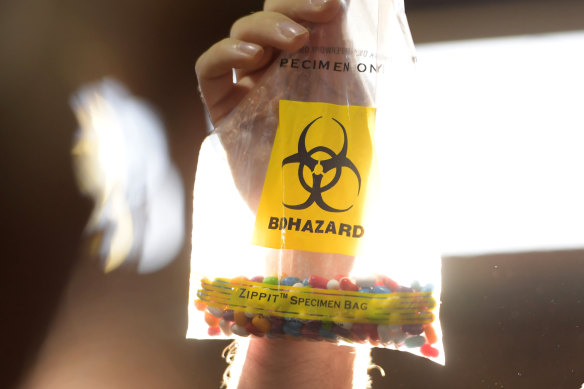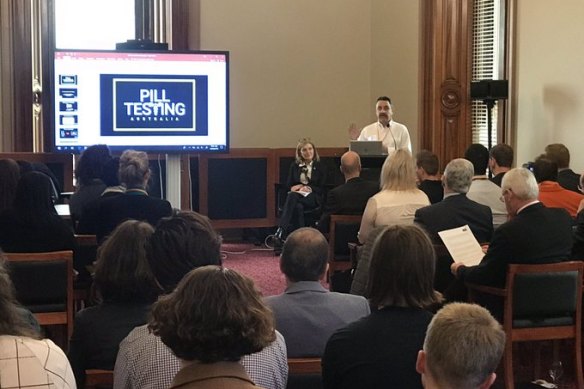This was published 11 months ago
The hidden costs that are killing live music festivals
Pill testing could make attendance at music festivals and events much safer - but only if the test providers can get insurance.
By Karl Quinn

Pill testing is set to become commonplace in most states, though New South Wales remains reluctant.Credit: Tracey Nearmy/Getty Images
Pill testing at music festivals is supposed to reduce risk. But as far as the insurance industry is concerned, it only increases it.
“Clearly it’s the legal liability,” Insurance Council of Australia senior policy officer Tom Lunn told a parliamentary inquiry in Canberra this week. “If you actually offer to provide some kind of service, automatically – notwithstanding you’re doing it out of goodwill to keep people safe – it can have some impacts on your liability. If you offer, for example, a pill-testing service.”
His colleague, the council’s general manager of regulatory and consumer policy, Alexandra Hordern, went further.
“Providing a pill-testing service may lead to a perception of a more permissive sort of safety culture,” she said. “And that may increase the risk among underwriters.”

Rising insurance costs are one of the major obstacles facing both festivals and fixed music venues.
At a time when Australia’s live music industry is under extreme pressure thanks to everything from extreme weather and the rising cost of touring, with even events once considered too big to fail like Splendour in the Grass being cancelled, the last thing the industry needs is a supposed salve – pill testing – turning into a financial nightmare.
For the cofounder of Harm Reduction Australia, Gino Vumbaca, the position of the insurance industry lobby group is beyond frustrating.
“We have provided reams of information to them, and they don’t even seem to read it. Our protocols are quite clear about what we’re doing,” he says.
Vumbaca says the work carried out by qualified volunteers under the auspices of Pill Testing Australia never includes advice that a drug is safe to consume. “Whether it’s alcohol, a legal or illegal drug, it doesn’t matter: there are potential harms from it that you tell people about. We never say, ‘Oh, you’re right to go’.”
Some people throw their drugs away after learning what’s in them, says Vumbaca. But if they choose to consume them regardless, the tester can hardly be held accountable, he argues.
“If you go to your doctor, and your doctor says: ‘You shouldn’t be smoking and drinking, and these are all the problems’, and then you go ahead and smoke and drink, can you sue your doctor? Of course not.”

Gino Vumbaca (right) presents to Victorian Parliament in 2019.Credit: Harm Reduction Australia
That gap on the issue of pill testing, which is now in place in the ACT and Queensland and soon to be trialled in Victoria, doesn’t merely represent a philosophical difference. It has practical implications.
When the first trials were carried out at Canberra’s Groovin the Moo festival in 2018, insurance cost $7000. But when they became official in 2022, Pill Testing Australia found it impossible to get coverage at all. And without insurance, there can be no testing.
More than a dozen insurers declined to cover the operation, many judging it to be “outside core risk appetite”, “outside underwriting guidelines”, or simply “not one for us”.
A couple of insurers did offer quotes – of $170,000 and $250,000. Ultimately, cover was found, at a cost of $80,000 per annum (the policy is national, and will cover operations in Victoria and any other states that adopt testing).
But this isn’t the only area where insurance has emerged as a key challenge for the live music and festival sector.
For some, it has become almost impossible to obtain. For others, it is merely prohibitively expensive; the ACT government submission, for instance, cites the case of a city nightclub that has experienced a 400 per cent increase in insurance costs from 2019 ($100,000) to 2023 ($500,000).
“Small venues with a focus on live music are not differentiated from large clubs and hotels, and insurers have generally taken a one-size-fits-all approach despite significant differences,” notes the Australian Small Business and Family Enterprise Ombudsman.
It’s tempting to paint the insurance companies as the villains in this scenario. But is that entirely fair?
The Insurance Council of Australia says premiums are up because claims are up. “Between 2009 and 2013, claims costs were largely stable,” Lunn told the inquiry. “But since 2015, claims costs have increased by an average of 5.5 per cent per annum.”
The average injury claim in Australia is now $130,000. About 5 per cent of all claims settle for more than $1 million. Psychological claims are having a “huge impact”, the council claimed. “It wasn’t there 10 to 15 years ago. Now it’s one of the largest components of a personal injury claim.”
The public liability sector is running at a loss, the council claimed, typically paying out 120 per cent of premiums (for every $1000 in policy revenue, claims cost $1200).
“There’s no doubt Australia is becoming an increasingly litigious society,” they added.
The trouble with those statistics, though, is that they offer little specific insight into the music industry. Indeed, the most recent report from the Australian Prudential Regulation Authority found that in the non-parks and gardens part of the cultural and recreation sector, “the loss ratio is more consistent and may be emerging lower in the 2018 to 2020 underwriting years”. Claims can take years to be settled, hence the lag.

The Canberra leg of Groovin the Moo hosted Australia’s first pill testing trials in 2018 and 2019. Credit: Rohan Thomson
Still, there’s little question the insurance industry sees the live music sector as fundamentally challenging. In its submission, the Insurance Council of Australia notes that factors such as “the service of alcohol, late operating hours, the use of staging, rigging and other equipment and a more fluid and mobile labour force” make live music venues “difficult to insure”.
One thing on which the music industry and the insurance lobby can agree is that reform is needed in the area of public liability.
“Festivals need a government-run or -backed insurance scheme,” the Australian Festival Association wrote in its submission. “We have been asking for this since the tail end of COVID.”
The Insurance Council argued: “There needs to be a review of current civil liability settings in Australia to ensure they remain fit for purpose and are conducive to ensuring ongoing insurance availability and accessibility.” Of course, any reforms there would flow on to areas beside the music sector, and that would be a massive win for the insurance industry as a whole.
Rising insurance costs are “clearly a priority area that requires a policy response or intervention for the industry to be sustainable”, wrote music industry consultant John Wardle. “This inquiry has an important role to play in developing solutions for the sector.”
Whether it can deliver them remains to be seen.